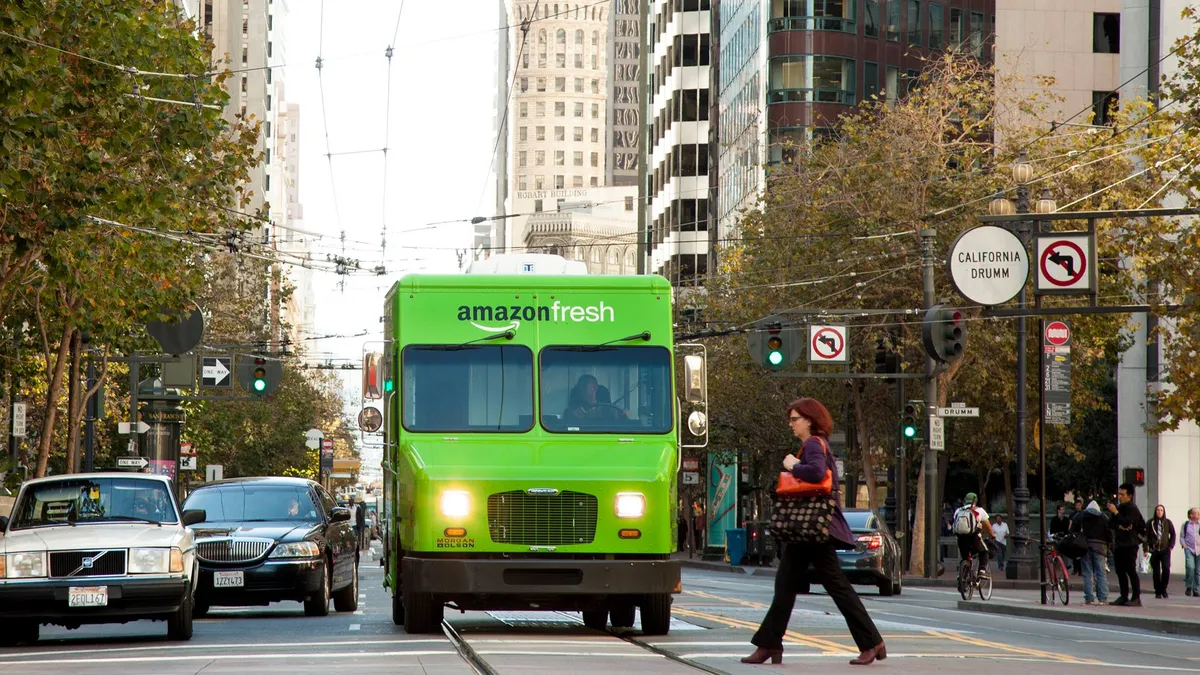Dive Brief:
- Though nearly 40% of U.S. consumers order groceries online weekly, a majority remain dissatisfied with delivery services, mainly due to high fees, lack of same-day delivery and late delivery, according to a recent Capgemini Research Institute study. Yet about three-quarters of the nearly 3,000 customers surveyed in five countries would be willing to spend more if they were satisfied with delivery services, the report found. Capgemini also interviewed 500 food and grocery supply chain executives in nine countries.
- More than half of consumers will regularly order groceries online by 2021. These shoppers are more likely to be to 26 to 45 years old, live in a metropolitan or urban area and are most often ordering fresh, chilled or frozen food, baby care products and alcohol. They also prefer subscription delivery plans and store pickup options, mainly to avoid delivery fees.
- Last-mile delivery costs retailers $10.10 on average, but customers cover about 80% of that cost, according to Capgemini’s research.
Dive Insight:
The latest research from Capgemini shows that despite the growth of online grocery, retailers' net profit could fall 26% in the next three years if last-mile solutions fail to radically improve.
Eight out of 10 U.S. consumers, most in medium to high-income brackets, shop for groceries online for the convenience it provides, slightly higher than the 76% average across countries Capgemini surveyed. Simultaneously, these same shoppers increasingly demand faster delivery: 55% report they would be more loyal to a retailer offering two-hour delivery, yet less than 20% of retailers offer that timeframe. Research also showed that a majority of consumers would switch to a competitor if promised faster service.
Generational gaps emerge when it comes to free shipping. Nearly 9 of 10 baby boomers expect free shipping, Supermarket News reported, compared to about 75% of Gen-X and Gen-Z customers — and only 61% of millennials. Shipping minimums and delivery fees stand to be the biggest hurdle for retailers, however, with 65% of consumers considering free-shipping thresholds before shopping.
Almost 60% of consumers believe delivery prices are too high, while about 45% lament the lack of same-day delivery and complain about frequent late deliveries. But these same customers aren't willing to pay more for better service, leaving retailers stuck in between a rock and a hard place. How can they balance consumer demand for the convenience of online ordering and their own bottom lines?
The future of grocery delivery could lie in subscription models. Amazon and Instacart seem to be relying on their membership fees to attract and retain customers, with the latter dropping its annual fee by one-third last November. Even non-members benefit from a $2 drop in delivery fees in most of North America, though one-hour deliveries, tack on an additional fee.
Autonomous vehicles will play a huge role in diminishing last-mile delivery costs, the report notes, especially as retailers eliminate minimum order requirements or limit delivery fees to build customer loyalty. The Capgemini report also encourages retailers to band together to improve supply chain and warehousing logistics, slimming costs with buying and shipping power.
Walmart's attention to last-mile delivery — with the help of several driverless vehicle and third-party delivery companies with varying degrees of influence throughout the U.S. — stands to boost the retail giant over Amazon in online grocery, according to a Deutsche Bank report. With nearly 20% of the market, Walmart requires a minimum order and charges a delivery fee regardless, while Kroger (through Instacart) and Target (through Shipt) offer free delivery with a $35 minimum order.
In addition to being more willing to try new offerings, nearly three-quarters of consumers spend more online than brick-and-mortar visits — 12% more on average. Positive experiences also benefit from word-of-mouth approval among friends and family, giving retailers reason to build loyalty with their regular customers.












